NZR RM class (Sentinel-Cammell)
The NZR RM class Sentinel-Cammell was a steam-powered railcar operated by the New Zealand Railways Department (NZR). It was the only one of its type to operate in New Zealand, and one of only two steam railcars trialled in the country; the other was the Clayton steam railcar.[1]
| NZ RM class Sentinel-Cammell | |||||||||||||
|---|---|---|---|---|---|---|---|---|---|---|---|---|---|
 | |||||||||||||
| |||||||||||||
| |||||||||||||
| |||||||||||||
| |||||||||||||
Overview
In the early 20th century, NZR began experiments with railcars as an option to replace unprofitable regional locomotive-hauled carriage expresses and to provide efficient passenger service on rural branch lines that were served solely by slow mixed trains that carried both goods and passengers.[1] In 1925, a steam railcar was ordered from the Sentinel Waggon Works of Shrewsbury and Metro-Cammell of Birmingham, and when it entered revenue service, it was the first railcar to do so in the Auckland Region.[2] It subsequently operated outside this region.[1]
In service
The railcar was not fast enough for the Melling Branch, so it was assigned to run a feeder service for the Night Limited express that ran between Wellington and Auckland. The feeder service operated from Thames along the Thames Branch[3] and met the express at Hamilton (Frankton Junction) before returning to Thames.[4] This service was not the sole domain of the Sentinel-Cammell steam railcar, it was sometimes operated by a carriage train hauled by steam locomotives such as the UD class. In 1928 it survived a collision with cows.[5]
Withdrawal
The Sentinel-Cammell steam railcar did not prove popular with passengers or crews and was not expanded into a full fleet. After a few years of service, it was quietly withdrawn and scrapped in 1931.[6]
Notes
- Bromby 2003, p. 122.
- Churchman & Hurst 2001, p. 109.
- "AtoJs Online — Appendix to the Journals of the House of Representatives — 1926 Session I — D-02 RAILWAYS STATEMENT BY THE MINISTER OF RAILWAYS, THE RIGHT HON. J. G. COATES". atojs.natlib.govt.nz. p. ix. Retrieved 12 June 2016.
- Bromby 2003, p. 123.
- "Local And General News". New Zealand Herald. 7 January 1928. p. 8. Retrieved 30 May 2016.
- Leitch & Stott 1988, p. 78.
References
- Bromby, Robin (2003). Rails that built a Nation: An Encyclopaedia of New Zealand Railways. Wellington: Grantham House. ISBN 1-86934-080-9.
- Churchman, Geoffrey B; Hurst, Tony (2001) [1990, 1991]. The Railways of New Zealand: A Journey through History (Second ed.). Transpress New Zealand. ISBN 0-908876-20-3.
- Leitch, David; Stott, Bob (1988). New Zealand Railways: The First 125 Years. Auckland: Heinemann Reed. p. 176. ISBN 0-7900-0000-8.
External links
- The Sentinel Cammell Steam Rail Car, Ohinemuri Regional History Journal 53, September 2009 – more details of the railcar on the Thames Branch.
- A Notable Rail Motor Service, The New Zealand Railways Magazine, Volume 2, Issue 5 (1 September 1927)
- 1925 photo of interior